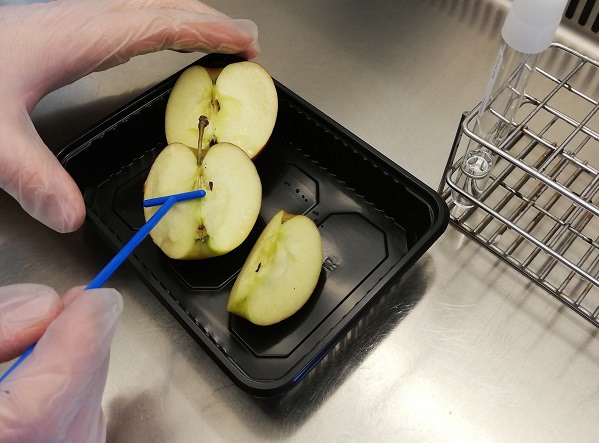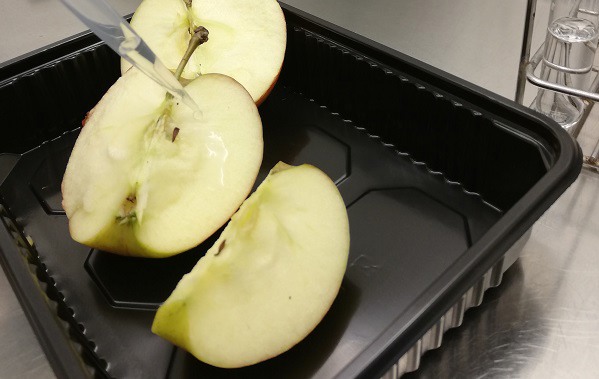Processed kale, endive, apples, and melons are convenient, but are they ready to eat? They are, if people eat them as is, but that significantly affects their BBD. In Europe, rules regarding Listeria have been tightened, which presents the chain with a new challenge. These requirements are not yet well in place at many companies, says Maria Lamers, quality consultant at Eurofins. "Real action is often only taken after a Netherlands Food and Consumer Safety Authority inspection (NVWA). And that generally leads to a re-inspection."

Listeria research
The NVWA assessment focuses mainly on how effective the preparation advice given was, and, given the 'reasonably expected use', if that advice is appropriate. That makes the discussion of whether something is a ready-to-eat product relevant. "Think of kale; nowadays, people use it raw in smoothie blends. Mushrooms are sometimes used raw in salads, as are diced bell peppers, sliced carrots, or julienned cabbage."
"And herring is topped with sliced onion. Those have all become ready-to-eat items, where you have to ensure that listeria doesn't get a chance to grow. Additives that can extend shelf life aren't permitted for most potato, fruit, and vegetable products. So, these products have a much shorter shelf life, or the packaging must clearly indicate that it must be heated thoroughly before consumption. Those are also often sold with longer shelf lives," Maria says.
After an NVWA review, a large fruit and vegetable processing company approached Maria for ideas about a melon cubes mix. This mix is an eg2073/2005 in the ready-to-eat products category, which means the growth potential of Listeria monocytogenes had to be researched. That, in turn, meant retaining the same shelf might not be possible.
"It's a washed, processed product with a pH of 5. Melons don't absorb pH-lowering, growth-inhibiting acids well at all. These affect their flavor too. Bacteriophages are something that could be added in the future, but these haven't yet been approved."
Preventing Listeria through testing and monitoring
Those producing ready-to-eat products with longer shelf lives than P+4 have to do a Listeria study to sustain those products' storage time. They must show that the products contain no more than 100 colony-forming units (CFU) of Listeria monocytogenes per gram by the end of their shelf life. "The annoying thing about Listeria monocytogenes is it's a bacteria that can still grow relatively quickly in the refrigerator (<7°C). Even when oxygen is removed by using gas packs," Maria explains.

"That's why you have to prove the listeria can't grow, by, say, modeling (theoretical growth models). Or by doing a challenge test that Eurofins uses to determine Listeria monocytogentic growth potential or rate in the product. We do so by deliberately infecting it. We can even calculate the growth on each day of shelf life using mathematical formulas. We can see that lower storage temperatures affect shelf life - a godsend for some food producers."
"There are simpler studies we can do too, where we only check if the product is a breeding ground for this Listeria species or not. Processed vegetables, in particular, are at risk because they're pH neutral. Except for melons and mango, most fruit is acidic enough to inhibit listeria growth, as long as it isn't ripe," adds Lamers.
Reducing shelf life can prevent Listeria, but that causes issues in the chain. Products that last only three days in the refrigerator are not popular with buyers. "These rules are quite new, so many companies are still uncertain because of the complexity. It's vital to start inventorying which products must be checked for Listeria: so which are pH-neutral and are (also) eaten raw."
 "During NVWA inspections and (customer) audits, they need to know Listeria monocytogenes prevalence in ready-to-eat products. I, therefore, advise companies to be proactive in the study and Listeria's presence in these products. It's beneficial to show how Listeria may grow and that laws and regulations are being fully followed," Maria concludes.
"During NVWA inspections and (customer) audits, they need to know Listeria monocytogenes prevalence in ready-to-eat products. I, therefore, advise companies to be proactive in the study and Listeria's presence in these products. It's beneficial to show how Listeria may grow and that laws and regulations are being fully followed," Maria concludes.
Maria Lamers Eurofins
Eurofins
NL: +31 (0) 888 310 000
BE: +32 (0) 504 50 060
customerservices-food-be@eurofins.com
www.eurofinsfoodtesting.be
www.eurofinsfoodtesting.nl
